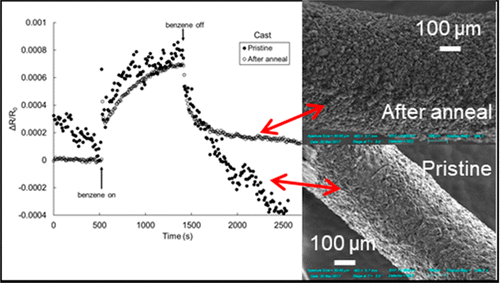Our official English website, www.x-mol.net, welcomes your
feedback! (Note: you will need to create a separate account there.)
Implications of Thermal Annealing on the Benzene Vapor Sensing Behavior of PEVA-Graphene Nanocomposite Threads
ACS Sensors ( IF 8.2 ) Pub Date : 2018-02-05 00:00:00 , DOI: 10.1021/acssensors.7b00912 Sanjay V Patel 1 , Sabina Cemalovic 1 , William K Tolley 1 , Stephen T Hobson 1 , Ryan Anderson 2 , Bernd Fruhberger 2
ACS Sensors ( IF 8.2 ) Pub Date : 2018-02-05 00:00:00 , DOI: 10.1021/acssensors.7b00912 Sanjay V Patel 1 , Sabina Cemalovic 1 , William K Tolley 1 , Stephen T Hobson 1 , Ryan Anderson 2 , Bernd Fruhberger 2
Affiliation

|
The effect of thermal treatments, on the benzene vapor sensitivity of polyethylene (co-)vinylacetate (PEVA)/graphene nanocomposite threads, used as chemiresistive sensors, was investigated using DC resistance measurements, differential scanning calorimetry (DSC), and scanning electron microscopy (SEM). These flexible threads are being developed as low-cost, easy-to-measure chemical sensors that can be incorporated into smart clothing or disposable sensing patches. Chemiresistive threads were solution-cast or extruded from PEVA and <10% graphene nanoplatelets (by mass) in toluene. Threads were annealed at various temperatures and showed up to 2 orders of magnitude decrease in resistance with successive anneals. Threads heated to ≥80 °C showed improved limits of detection, resulting from improved signal–noise, when exposed to benzene vapor in dry air. In addition, annealing increased the speed of response and recovery upon exposure to and removal of benzene vapor. DSC results showed that the presence of graphene raises the freezing point, and may allow greater crystallinity, in the nanocomposite after annealing. SEM images confirm increased surface roughness/area, which may account for the increase response speed after annealing. Benzene vapor detection at 5 ppm is demonstrated with limits of detection estimated to be as low as 1.5 ppm, reflecting an order of magnitude improvement over unannealed threads.
中文翻译:

热退火对 PEVA-石墨烯纳米复合线苯蒸汽传感行为的影响
使用直流电阻测量、差示扫描量热法 (DSC) 和扫描电子显微镜研究了热处理对用作化学电阻传感器的聚乙烯(共)醋酸乙烯酯 (PEVA)/石墨烯纳米复合材料线的苯蒸气敏感性的影响。扫描电镜)。这些柔性线正在被开发为低成本、易于测量的化学传感器,可以集成到智能服装或一次性传感贴片中。耐化学性线由 PEVA 和 <10% 石墨烯纳米片(按质量计)在甲苯中溶液浇铸或挤出而成。螺纹在不同的温度下进行退火,随着连续退火,电阻降低了 2 个数量级。当线暴露于干燥空气中的苯蒸气时,加热至 ≥80 °C 的线显示出更高的检测限,这是由于信号噪声的改善所致。此外,退火提高了暴露于苯蒸气并除去苯蒸气后的响应和恢复速度。 DSC 结果表明,石墨烯的存在提高了退火后纳米复合材料的凝固点,并可能允许更大的结晶度。 SEM 图像证实表面粗糙度/面积增加,这可能是退火后响应速度增加的原因。经证实,苯蒸气检测浓度为 5 ppm,检测限估计低至 1.5 ppm,反映出比未退火螺纹提高了一个数量级。
更新日期:2018-02-05
中文翻译:

热退火对 PEVA-石墨烯纳米复合线苯蒸汽传感行为的影响
使用直流电阻测量、差示扫描量热法 (DSC) 和扫描电子显微镜研究了热处理对用作化学电阻传感器的聚乙烯(共)醋酸乙烯酯 (PEVA)/石墨烯纳米复合材料线的苯蒸气敏感性的影响。扫描电镜)。这些柔性线正在被开发为低成本、易于测量的化学传感器,可以集成到智能服装或一次性传感贴片中。耐化学性线由 PEVA 和 <10% 石墨烯纳米片(按质量计)在甲苯中溶液浇铸或挤出而成。螺纹在不同的温度下进行退火,随着连续退火,电阻降低了 2 个数量级。当线暴露于干燥空气中的苯蒸气时,加热至 ≥80 °C 的线显示出更高的检测限,这是由于信号噪声的改善所致。此外,退火提高了暴露于苯蒸气并除去苯蒸气后的响应和恢复速度。 DSC 结果表明,石墨烯的存在提高了退火后纳米复合材料的凝固点,并可能允许更大的结晶度。 SEM 图像证实表面粗糙度/面积增加,这可能是退火后响应速度增加的原因。经证实,苯蒸气检测浓度为 5 ppm,检测限估计低至 1.5 ppm,反映出比未退火螺纹提高了一个数量级。











































 京公网安备 11010802027423号
京公网安备 11010802027423号